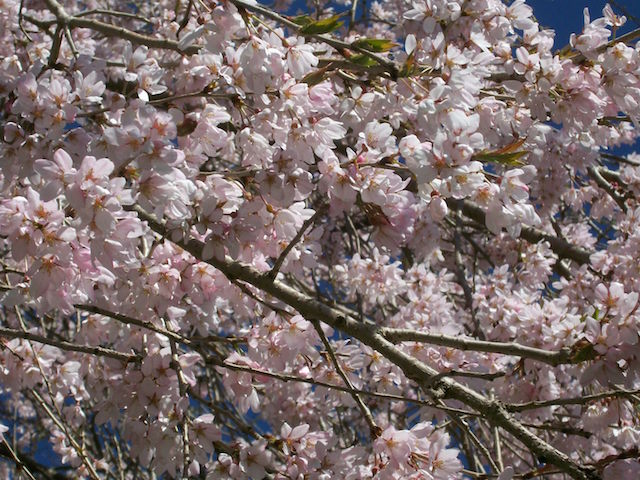Brenda sent me some photos of the weeping cherry in her front yard. She wrote: “I believe it is a native because I dug it up on one of the mountains in Emmitsburg 30+ years ago!”
Time for some research!
Brenda’s weeping cherry tree is most likely Prunus x subhirtella, a naturally occurring hybrid, called a Higan cherry which originates in Japan. It has pale pinkish-white non-fragrant flowers that can produce small pea sized fruit that the birds will eat. But, you don’t often find this one in commerce. You can find upright Higan’s, however.
Go to most purveyors of woody plants, and you will typically find a weeping Higan cherry, that is actually a graft of cultivars– Autumn Rosea (double pink), Snow Fountain or ‘Pendula’ ( weeping-white to pink) on top of a hardy cherry rootstock- like a Mazzard or wild cherry. The base needs to have a straight trunk which will then be cut off at about 5 feet up and the ornamental weeping cultivar will be grafted on. See, weeping cherries grown at ground level (own root) don’t typically have enough height to effect the weeping form. As soon as their branches touch ground, the branches stop growing. So, what about Brenda’s dug plant? I suspect that it was bird planted and in the competition for light, it grew taller. We see this often in woodlands– a long expanse of trunk before branching. So, Brenda lucked out in finding a cherry tree not requiring any help to show a weeping form.
Here’s what you should know about the grafted weepers; they’ve got a high failure rate between problems with the graft base and with the weeping graft. Then there is maintenance: any sprouts or suckers on the trunk, especially below the graft scar or on the rootstock will grow straight up–goodbye weeping form. They must be removed. The graft is often a weak point and the grafted form is deemed generally less healthy to natural types.
The trees are attacked by Japanese beetles, tent caterpillars, scale, borers and so forth. So, BT, milky spore and a spraying regime may be considered. Dieback, root rot and fireblight are other possible problems; two kinds of cherries together increases the number of potential attacks. Growers know this well. A non-grafted type is just lower maintenance.
To best effect, avoid trimming the weeping branches into a bowl haircut effect. As mentioned, they will stop growing once they touch the ground. Wherever trimmed, the branches will fork, so you can thicken the effect. On a grafted type, trim within a foot or two above the graft.Higans are hardy to zone 4 and bloom in April, potentially reaching 30Hx25W. They are more tolerant to summer and winter temperature extremes than other flowering cherries. Of course, best flowering is in full sun.
Interesting note: Japanese gardens don’t typically contain flowering cherries. Instead, they are typically used as park plantings that celebrate life’s ephemeral qualities (short but beautiful bloom time). In Japan, one traditional bacchanalian holiday loved especially by the younger set is Hanami, (Flower Viewing), celebrated by food and drunken saki picnics on blankets beneath the trees. It can get rowdy. Older folks enjoy the quieter “Umemi’ or plum viewing which comes later.
Here is the blossom close up of Brenda’s weeping cherry:



1 comment for “Brenda’s Weeping Cherry”